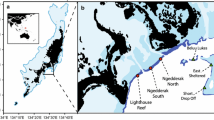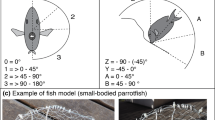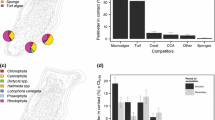Abstract
Extreme disturbances often lead to community reorganisations, yet sometimes ecosystems unexpectedly fail to recover. Such surprising outcomes may pinpoint important yet overlooked mechanisms that drive ecosystems into undesirable states. Using long-term field observations, experimental manipulations and mechanistic modelling, we document the drivers of an unexpected phase shift from coral to macroalgal dominance following typhoon disturbance on reefs in Palau (Micronesia). After extensive coral mortality, an ephemeral bloom of a canopy-forming macroalga (Liagora sp.) provided physical refuge from herbivore grazing, resulting in the establishment of a secondary, understory macroalga (Lobophora spp.). After disappearance of Liagora canopies and resulting loss of grazing refuge, the Lobophora patches continued to expand and led to a macroalgal (Lobophora-) dominated state that has persisted for more than 2 years. We developed a mechanistic model of Lobophora patch dynamics parameterised with rates of growth measured in situ to simulate the observed proliferation of Lobophora under variable grazing refuges in space and time. Model simulations showed that short-term escapes from grazing were pivotal in allowing establishment of patches of Lobophora. Ephemeral grazing refuges created an opportunity to reach a cover above which Lobophora growth exceeds grazing, so that Lobophora could expand after disappearance of Liagora canopies. Critically, in the absence of grazing refuge, herbivore biomass was sufficient to prevent the establishment of Lobophora patches. Our model demonstrates that with rapid algal growth and low grazing, a relatively minor grazing refuge (6 month) is sufficient to escape herbivore control after extensive coral mortality, leading to unexpected recovery failure. Transient fluctuations in the intensity of control mechanisms, such as herbivore grazing, can have disproportionate and long-lasting effects on community structure. Overall, this study stresses that our perception of reef dynamics must integrate the time scales at which reefs can be sensitive to transient changes in mechanisms promoting coral dominance.






Similar content being viewed by others
References
Anthony K, Maynard JA, Diaz-Pulido G, Mumby PJ, Marshall PA, Cao L, Hoegh-Guldberg O. 2011. Ocean acidification and warming will lower coral reef resilience. Glob Change Biol 17:1798–808.
Aronson RB, Precht WF. 2001. White-band disease and the changing face of Caribbean coral reefs. Hydrobiologia 460:25–38.
Bellwood DR, Hughes TP, Folke C, Nyström M. 2004. Confronting the coral reef crisis. Nature 429:827–33.
Benedetti-Cecchi L. 2003. The importance of the variance around the mean effect size of ecological processes. Ecology 84:2335–46.
Bennett S, Vergés A, Bellwood DR. 2010. Branching coral as a macroalgal refuge in a marginal coral reef system. Coral Reefs 29:471–80.
Bozec Y-M, Mumby PJ. 2015. Synergistic impacts of global warming on the resilience of coral reefs. Philos Trans R Soc B 370:20130267.
Bozec Y-M, O’Farrell S, Bruggemann JH, Luckhurst BE, Mumby PJ. 2016. Tradeoffs between fisheries harvest and the resilience of coral reefs. Proc Natl Acad Sci 113:4536–41.
Bruno J, Siddon C, Witman J, Colin P, Toscano M. 2001. El Nino related coral bleaching in Palau, western Caroline Islands. Coral Reefs 20:127–36.
Bruno JF, Sweatman H, Precht WF, Selig ER, Schutte VG. 2009. Assessing evidence of phase shifts from coral to macroalgal dominance on coral reefs. Ecology 90:1478–84.
Castro-Sanguino C, Lovelock C, Mumby PJ. 2016. The effect of structurally complex corals and herbivory on the dynamics of Halimeda. Coral Reefs 35:597–609.
Cheal AJ, MacNeil MA, Cripps E, Emslie MJ, Jonker M, Schaffelke B, Sweatman H. 2010. Coral–macroalgal phase shifts or reef resilience: links with diversity and functional roles of herbivorous fishes on the Great Barrier Reef. Coral Reefs 29:1005–15.
Clements KD, German DP, Piché J, Tribollet A, Choat JH. 2016. Integrating ecological roles and trophic diversification on coral reefs: multiple lines of evidence identify parrotfishes as microphages. Biol J Linn Soc 120:729–51.
Coen LD, Tanner CE. 1989. Morphological variation and differential susceptibility to herbivory in the tropical brown alga Lobophora variegata. Mar Ecol Prog Ser 54:287–98.
Cuddington K, Fortin M-J, Gerber LR, Hastings A, Liebhold A, O’connor M, Ray C. 2013. Process-based models are required to manage ecological systems in a changing world. Ecosphere 4:20.
Denny MW, Hunt LJ, Miller LP, Harley CD. 2009. On the prediction of extreme ecological events. Ecol Monogr 79:397–421.
Diaz-Pulido G, McCook LJ, Dove S, Berkelmans R, Roff G, Kline DI, Weeks S, Evans RD, Williamson DH, Hoegh-Guldberg O. 2009. Doom and boom on a resilient reef: climate change, algal overgrowth and coral recovery. PLoS ONE 4:e5239.
Doak DF, Estes JA, Halpern BS, Jacob U, Lindberg DR, Lovvorn J, Monson DH, Tinker MT, Williams TM, Wootton JT. 2008. Understanding and predicting ecological dynamics: are major surprises inevitable. Ecology 89:952–61.
Done TJ. 1992. Phase shifts in coral reef communities and their ecological significance. Hydrobiologia 247:121–32.
Done T, Turak E, Wakeford M, DeVantier L, McDonald A, Fisk D. 2007. Decadal changes in turbid-water coral communities at Pandora Reef: loss of resilience or too soon to tell? Coral Reefs 26:789–805.
Doropoulos C, Roff G, Bozec Y-M, Zupan M, Werminghausen J, Mumby PJ. 2016. Characterizing the ecological trade-offs throughout the early ontogeny of coral recruitment. Ecol Monogr 86:20–44.
Doropoulos C, Roff G, Visser M-S, Mumby PJ. 2017. Sensitivity of coral recruitment to subtle shifts in early community succession. Ecology 98:304–14.
Doropoulos C, Roff G, Zupan M, Nestor V, Isechal AL, Mumby PJ. 2014. Reef-scale failure of coral settlement following typhoon disturbance and macroalgal bloom in Palau, Western Pacific. Coral Reefs 33:613–23.
Dray S, Dufour A-B. 2007. The ade4 package: implementing the duality diagram for ecologists. J Stat Softw 22:1–20.
Evans MR, Bithell M, Cornell SJ, Dall SR, Díaz S, Emmott S, Ernande B, Grimm V, Hodgson DJ, Lewis SL. 2013. Predictive systems ecology. Proc R Soc B Biol Sci 280:20131452.
Ferrari R, Gonzalez-Rivero M, Ortiz JC, Mumby PJ. 2012. Interaction of herbivory and seasonality on the dynamics of Caribbean macroalgae. Coral Reefs 31:683–92.
Fox RJ, Bellwood DR. 2007. Quantifying herbivory across a coral reef depth gradient. Mar Ecol Prog Ser 339:49–59.
Fung T, Seymour RM, Johnson CR. 2011. Alternative stable states and phase shifts in coral reefs under anthropogenic stress. Ecology 92:967–82.
Gaines SD, Denny MW. 1993. The largest, smallest, highest, lowest, longest, and shortest: extremes in ecology. Ecology 74:1677–92.
Golbuu Y, Victor S, Penland L, Idip D Jr, Emaurois C, Okaji K, Yukihira H, Iwase A, Van Woesik R. 2007. Palau’s coral reefs show differential habitat recovery following the 1998-bleaching event. Coral Reefs 26:319–32.
Graham NA, Jennings S, MacNeil MA, Mouillot D, Wilson SK. 2015. Predicting climate-driven regime shifts versus rebound potential in coral reefs. Nature 518:94–7.
Hastings A. 2004. Transients: the key to long-term ecological understanding? Trends Ecol Evol 19:39–45.
Hay ME. 1981. Spatial patterns of agrazing intensity on a caribbean barrier reef: herbivory and algal distribution. Aquat Bot 11:97–109.
Hixon MA, Brostoff WN. 1996. Succession and herbivory: effects of differential fish grazing on Hawaiian coral-reef algae. Ecol Monogr 66:67–90.
Holling CS. 1996. Surprise for science, resilience for ecosystems, and incentives for people. Ecol Appl 6:733–5.
Hughes TP. 1994. Catastrophes, phase shifts, and large-scale degradation of a Caribbean coral reef. Science 265:1547–51.
Kuffner IB, Walters LJ, Becerro MA, Paul VJ, Ritson-Williams R, Beach KS. 2006. Inhibition of coral recruitment by macroalgae and cyanobacteria. Mar Ecol Prog Ser 323:107–17.
Lewis SM. 1986. The role of herbivorous fishes in the organization of a Caribbean reef community. Ecol Monogr 56:183–200.
Lindenmayer DB, Likens GE, Krebs CJ, Hobbs RJ. 2010. Improved probability of detection of ecological “surprises”. Proc Natl Acad Sci 107:21957–62.
Lubchenco J, Gaines SD. 1981. A unified approach to marine plant-herbivore interactions. I. Populations and communities. Annu Rev Ecol Syst 12:405–37.
McManus JW, Polsenberg JF. 2004. Coral–algal phase shifts on coral reefs: ecological and environmental aspects. Prog Oceanogr 60:263–79.
Morrison D. 1988. Comparing fish and urchin grazing in shallow and deeper coral reef algal communities. Ecology 69:1367–82.
Mumby PJ. 2006. The impact of exploiting grazers (Scaridae) on the dynamics of Caribbean coral reefs. Ecol Appl 16:747–69.
Mumby PJ, Bejarano S, Golbuu Y, Steneck RS, Arnold SN, Van Woesik R, Friedlander AM. 2013. Empirical relationships among resilience indicators on Micronesian reefs. Coral Reefs 32:213–26.
Mumby PJ, Hastings A, Edwards HJ. 2007. Thresholds and the resilience of Caribbean coral reefs. Nature 450:98–101.
Mumby PJ, Steneck RS. 2008. Coral reef management and conservation in light of rapidly evolving ecological paradigms. Trends Ecol Evol 23:555–63.
Mumby PJ, Steneck RS, Adjeroud M, Arnold SN. 2016. High resilience masks underlying sensitivity to algal phase shifts of Pacific coral reefs. Oikos 125:644–55.
Mumby PJ, Wolff NH, Bozec Y-M, Chollett I, Halloran P. 2014. Operationalizing the resilience of coral reefs in an era of climate change. Conserv Lett 7:176–87.
Paine RT, Tegner MJ, Johnson EA. 1998. Compounded perturbations yield ecological surprises. Ecosystems 1:535–45.
Paul VJ, Hay ME. 1986. Seaweed susceptibility to herbivory: chemical and morphological correlates. Mar Ecol Prog Ser 33:255–64.
Pillans RD, Franklin CE, Tibbetts IR. 2004. Food choice in Siganus fuscescens: influence of macrophyte nutrient content and availability. J Fish Biol 64:297–309.
R Core Team (2015). R: a language and environment for statistical computing. R Foundation for Statistical Computing, Vienna, Austria. https://www.R-project.org/.
Ritz C, Streibig JC. 2008. Nonlinear regression with R. Berlin: Springer.
Roff G, Chollett I, Doropoulos C, Golbuu Y, Steneck RS, Isechal AL, van Woesik R, Mumby PJ. 2015a. Exposure-driven macroalgal phase shift following catastrophic disturbance on coral reefs. Coral Reefs 34:715–25.
Roff G, Doropoulos C, Zupan M, Rogers A, Steneck RS, Golbuu Y, Mumby PJ. 2015b. Phase shift facilitation following cyclone disturbance on coral reefs. Oecologia 178:1193–203.
Roff G, Mumby PJ. 2012. Global disparity in the resilience of coral reefs. Trends Ecol Evol 27:404–13.
Sandin SA, McNamara DE. 2012. Spatial dynamics of benthic competition on coral reefs. Oecologia 168:1079–90.
Scheffer M, Bascompte J, Brock WA, Brovkin V, Carpenter SR, Dakos V, Held H, Van Nes EH, Rietkerk M, Sugihara G. 2009. Early-warning signals for critical transitions. Nature 461:53–9.
Scheffer M, Carpenter SR. 2003. Catastrophic regime shifts in ecosystems: linking theory to observation. Trends Ecol Evol 18:648–56.
Scheffer M, Van Nes EH, Holmgren M, Hughes T. 2008. Pulse-driven loss of top-down control: the critical-rate hypothesis. Ecosystems 11:226–37.
Sotka EE, Hay ME. 2009. Effects of herbivores, nutrient enrichment, and their interactions on macroalgal proliferation and coral growth. Coral Reefs 28:555–68.
Steneck RS. 1988. Herbivory on coral reefs: a synthesis. Proc 6th Int Coral Reef Symp 1:37–49.
Vieira C, Thomas OP, Culioli G, Genta-Jouve G, Houlbreque F, Gaubert J, De Clerck O, Payri CE. 2016. Allelopathic interactions between the brown algal genus Lobophora (Dictyotales, Phaeophyceae) and scleractinian corals. Sci Rep 6:18637.
Williams ID, Polunin NV, Hendrick VJ. 2001. Limits to grazing by herbivorous fishes and the impact of low coral cover on macroalgal abundance on a coral reef in Belize. Mar Ecol Prog Ser 222:187–96.
Williams JW, Jackson ST. 2007. Novel climates, no-analog communities, and ecological surprises. Front Ecol Environ 5:475–82.
Wilson SK, Bellwood DR, Choat JH, Furnas MJ. 2003. Detritus in the epilithic algal matrix and its use by coral reef fishes. Oceanogr Mar Biol Annu Rev 41:279–309.
Acknowledgements
The authors would like to thank C. Castro-Sanguino and G. Diaz-Pulido for helpful comments and discussions.
Author information
Authors and Affiliations
Corresponding author
Additional information
Authors’ Contribution
Y-MB and PJM conceived the methodology; CD and GR collected the benthic cover data and ran the caging experiment with PJM; PJM conducted fish surveys; Y-MB estimated macroalgal covers from photographs, performed data analysis and modelling, and completed manuscript preparation. All authors assisted in data and model interpretation, and manuscript revision.
Electronic supplementary material
Below is the link to the electronic supplementary material.
Rights and permissions
About this article
Cite this article
Bozec, YM., Doropoulos, C., Roff, G. et al. Transient Grazing and the Dynamics of an Unanticipated Coral–Algal Phase Shift. Ecosystems 22, 296–311 (2019). https://doi.org/10.1007/s10021-018-0271-z
Received:
Accepted:
Published:
Issue Date:
DOI: https://doi.org/10.1007/s10021-018-0271-z




